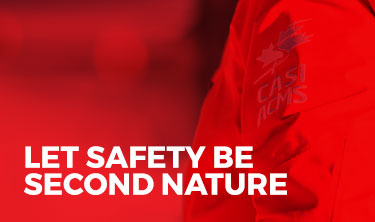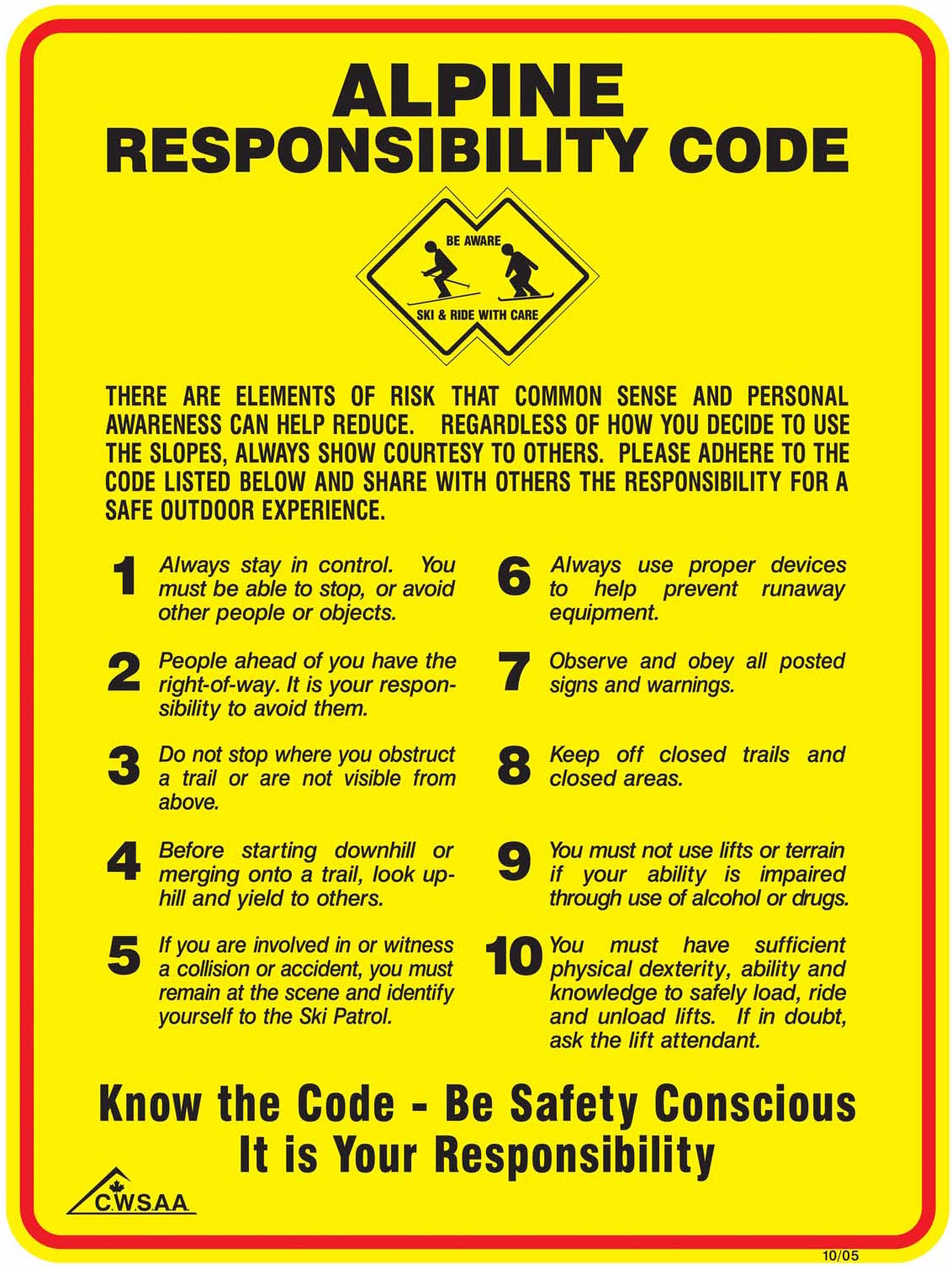Let Safety Be Second Nature
- Details
- Category: CASI BLOG

The season is in full swing, and many of us are already busy teaching snowboard lessons, programs or certification courses. As instructors and trainers, we have a responsibility to ensure the safety of our students because risk is omnipresent in the resort environment. We must all do our best to ensure the safety of our students, and sometimes this role takes on the air of being a guide or protective parent.
In this article, we'll talk about safety and remind you of a few best practices within your lessons, be them private or group, with children, teens or adults.
Please note that this article is not exhaustive and you likely have a wealth of other safety tips and tricks that you use in your lessons.
LEAD BY EXAMPLE
It's important to be aware of the safety rules in place at your resort and to lead by example. Some rules may also vary from one resort to the next. Here are some important reminders:
- Know and respect the Alpine Responsibility Code.
- Know and respect the CASI code of ethics for instructors, which refers to best practices on the mountain;
- Know and respect the procedures specific to the resort or Snow School.

CLASS MANAGEMENT AND ANTICIPATION OF DANGER
To keep our groups safe, we must first anticipate dangers by giving clear and specific instructions. Instructors must be vigilant and responsible at all times. Here are some examples of good class management and guest services:
- Establish a re-grouping point at the top and at the base, taking into account any resort specific considerations that could lead to student confusion (different slopes, etc.).
- Ask all students to wait for the rest of the group at all intersections if they are unsure of which run to take.
- Do frequent headcounts in your group.
- In group lessons, stay as close together as possible within reason.
- Use the most independent students to lead the group to a specific point.
- Choose the terrain according to the students' skill level and re-evaluate these decisions regularly.
- In the event of varied skill levels, ensure that the terrain choice is not too advanced for the weakest student.
- Depending on the teaching situation, warn the group or the instructor, (shout or send someone if a student has fallen behind).
- When riding through glades, always put students in teams of two or three so they can look out for each other.
- Only bring students into the glades when they demonstrate good control and the ability to stop quickly...the trees won't budge!
- Trails with natural obstacles such as glades and moguls should be reserved for students who are advanced enough to use them.
- Use terrain parks if you have the knowledge and if your school policy allows it.
Remind students often to:
- Stay in control;
- Frequently check the condition of their equipment (tight screws, missing parts, etc.);
- Look uphill and check blind spots before crossing a run or changing width of turns;
- Preferably stop at the side of the trail, but ALWAYS in a place that is clearly visible to other downhill traffic;
- Have students stop at the bottom of the group when rejoining it, to avoid collisions;
- Ideally, stand when stopped, either with one foot detached or with both feet (standing is more visible than sitting).
TIPS FOR GOOD CLASS MANAGEMENT
Monitor your students' physical and psychological state by observing and checking in with them throughout the lesson. Be aware of their state from beginning to end.
Ask yourself and your students:
- Are they showing signs of fatigue?
- Do they seem too cold or warm?
- Are they energetic?
- Did they eat a full lunch, or just a snack? Are they hydrated?
- Do they seem discouraged or tired? Perhaps a break is in order?
- Maybe a hot chocolate or coffee would be the best thing to do?
- For more advanced lessons, this can be a good time to talk technique if needed, analyze a video, and so on.
- Is an extra run at the end of the day going to be counterproductive or dangerous? Maybe we should stop a little earlier?
- Depending on the age and ability of students, head to the base to do some easier exercises, or just play without the board.
USE LIFTS RESPONSIBLY
Before riding a lift with a student or your group, make sure everyone knows how to use the lift, including how to get on at the bottom and off at the top.
Ask your students questions to check their knowledge and run simulations before they get in line to wait for the lift. It's important to remember that taking the lift can be intimidating for beginners.
TIPS FOR RIDING LIFTS WITH YOUR STUDENTS:
- Carry out simulations of all types of lifts until students feel comfortable and ready.
- Use a bamboo or ski pole to simulate using a T-bar or poma lift for the first time.
- If you have a group of several students, use the help of experienced skiers or snowboarders to accompany your students on the lifts so that no rider is left alone - this is essential for groups of young children.
- Let students know where to meet at the top of the lift. If it's very busy, you can even ask the person from the lift line you had to help out to wait at the top until you've arrived.
- Always take the lifts last to make sure everyone has made it to the top.
BEST PRACTICES BY LIFT TYPE:
For magic carpets:
- Demonstrate the first time you use the carpet and show your students how to balance on the moving conveyor, ie. how to place their free foot on the board to promote balance.
- Make sure they know what to do if they fall. Either get back on their feet and continue to the top, step off to the side and start again or walk up.
- As much as possible, keep your students in sight at all times on the lifts. If a student falls, this will enable you to ask the lift attendant to stop the lift quickly and/or to assist your students if they have difficulty getting up.
For chair lifts:
- Lower the chairlift's safety bar;
- Sit firmly on chairlift, with your back against the backrest;
- Do not rock the chair, remain calm during the ascent;
- Raise the bar where it has been indicated (usually at the last lift tower) before arriving at the drop-off zone.
For T-Bar or Poma lifts:
- To introduce your students to this type of lift, choose a lift that makes it easy to disembark in the event of a fall; ideally with a slope that's not too steep to climb for beginners.
- If this isn't possible, use what you've got but make sure to progress gradually. Your students should be well prepared before using the lift for the first time. In some lifts of this type (depending on resort rules) it is possible to disembark before the slope becomes too steep. You could therefore start with this option, and repeat until students feel ready to slide up higher.
- Give clear instructions in the event of a fall:
- Clear the ascent route as quickly as possible and wait for the rest of the group on the side of the run in a place that is visible to descending snowboarders/skiers.
- Instructors could advise the group to meet up at the top (or at the first landing zone if applicable) and then join the student(s) who fell. Alternatively, the instructor could ask the full group to descend and start over. Be sure that everyone hears the instructor’s plan before getting on the lift.
- You can also ask for the help of a patroller, resort employee or trusted adult to find the group and wait with them until the instructor returns or ask this person to stay with the student who has fallen until the instructor returns with the rest of the group.
CONCLUSION
As instructors, we must always be aware of the inherent dangers in snow sports in order to better anticipate them and avoid accidents, regardless of severity.
Despite all our best intentions and the use of best practices, risks are real and sometimes unavoidable no matter the level of skill. Being vigilant at all times, we can avoid or at least minimize the implicit risks associated with snow sports.
The safety of our students must remain a deeply embedded part of all aspects of our lessons, sessions and courses. Small details are important and a safe lesson will no doubt provide an excellent guest experience and encourage the learner to return.
We need to learn to listen to our internal voice of reason and follow our intuition in order to become sovereigns of safety! Managing our lessons and groups safely should be second nature.
Geneviève Pilotto
Program Director, CASI-ACMS
PRO DEAL MERCHANDISE SUPPLIERS

Our Mission: To inspire the world’s best snowboard instruction.
Our Vision: To be the global leaders in instructor education, innovation and professional development that is synonymous with a thriving, diverse and accessible snow sports industry.
REGIONAL COORDINATORS
LUC BELANGER
QUEBEC & ATLANTIC
luc@casi-acms.comANDREW MCCRANEY
ONTARIO, MANITOBA & SASKATCHEWAN
andrew@casi-acms.comADAM GARDNER
ALBERTA & BC EAST
adam@casi-acms.comGREG DANIELLS (INDUSTRY INQUIRIES)
BC WEST, NWT & YUKON
greg@casi-acms.comLISA CORCORAN (MEMBER / COURSE REQUESTS)
BC WEST, NWT & YUKON
bcadmin@casi-acms.com

























































